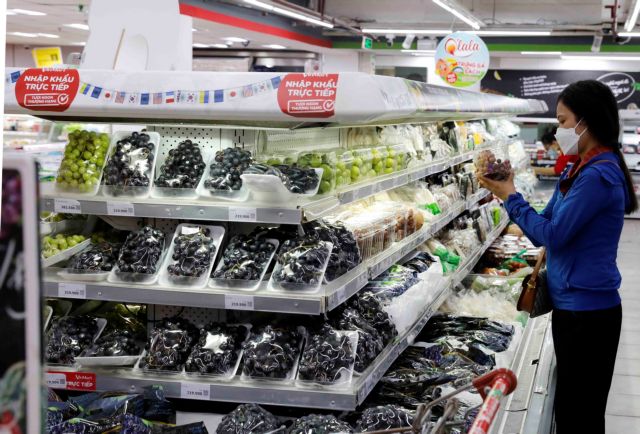
HÀ NỘI — Domestic purchasing power has rebounded after a strong decline caused by the COVID-19 pandemic. That rebound has facilitated businesses to step up production and seize new opportunities, experts have said.
The nation’s total revenue from retail trade and services surpassed VNĐ1.77 quadrillion (US$76.2 billion) in the first four months of 2022, up 6.5 per cent year-on-year, the latest report from the Ministry of Industry and Trade (MoIT) showed.
In April alone, the revenue also saw a positive yearly rise of 12 per cent to over VNĐ455 trillion, according to the report.
These encouraging figures were attributable to abundant good supply and increasing purchasing power in the domestic market, the MoIT said, adding that goods retail sales saw a year-on-year hike of 7.6 per cent to over VNĐ1.42 quadrillion in the four months. Of this, sales of food and foodstuff rose 13.2 per cent year-on-year and that of cultural and educational products increased 11.5 per cent.
In the four-month period, restaurant and accommodation revenues totalled nearly VNĐ171 trillion, up 5.2 per cent, while tourism revenue stood at over VNĐ4.3 trillion, up 10.5 per cent year-on-year as tourism activities gradually returned after the Government agreed to reopen inbound and outbound international flights from March 15.
During April 30 and May 1, many travel businesses experienced a sudden increase in the number of tourists, such as Saigontourist, which served between 30,000 and 50,000 visitors; Vietravel and Vietnam Travelmart which welcomed 4,000 visitors each. The number of customers booking tours with Fiditour increased 30-40 per cent over the same period last year, news site vnbusiness.vn reported.
Statistics from the Việt Nam Administration of Tourism said the tourism sector served nearly five million domestic visitors between April 30 and May 1, earning a revenue of about VNĐ22 trillion.
According to analysts, the domestic market has been gradually recovering, regaining its growth momentum. However, these signals are just the start of a recovery road ahead.
Nguyễn Đình Cung, former director of the Central Institute for Economic Management, told vnbusiness.vn that during the COVID-19 pandemic, many consumers had to tighten their spending, leading to a sharp drop in consumption power. Until now, the pandemic had been gradually controlled, but the trend of tightening spending could be maintained because many people’s jobs and income sources were still precarious.
According to Cung, people who could afford to travel were those with stable incomes and money to spare. But those who were workers and freelancers failed to have sufficient money to speed up their spending.
Thus, it was necessary for the State to draw up policies to support the stability of the labour market and stimulate purchasing power through tax reduction, Cung said.
Meanwhile, rising commodity prices would likely affect consumer spending.
Thảo, who runs a grocery store Hà Nội’s Bắc Từ Liêm District, said he was concerned about the price of many essential consumer goods gradually increasing as he imported these items for his shop.
Whenever customers wondered, Thảo had to explain to them that the prices of many essential goods, from yoghurt and cheese to cooking oil and soap, had increased.
Vietnamese goods for Vietnamese people
Despite an encouraging increase in retail sales of food and foodstuffs, other products like garments and appliances, tools and household equipment decreased by 3.5 per cent and 4.6 per cent, respectively in the four-month period as the prolonged pandemic affected the income of many households, the MoIT said in its report.
Sharing with vnbusiness.vn, Phạm Văn Việt, general director of Việt Thắng Jean Co (VitaJean), said that the market grew about 10 per cent in the period. However, this growth is still lower than the 15-20 per cent recorded in the pre-pandemic period.
Thus, VitaJean only launched a new product collection with a size equal to one-third of the collections before 2020. The debut of the new collection was based on the calculation of consumption and inventory, Việt said.
In spite of the firm’s experience in conquering strict markets such as the EU and the US, they still encountered difficulties in bringing garment products to the Vietnamese people.
Amid the pandemic, many foreign fashion brands such as H&M and Zara were constantly expanding their distribution systems thanks to their strong financial capacities.
Meanwhile, Vietnamese garment enterprises found it difficult to seize untapped opportunities for garment and textile products in the local market due to disadvantages in raw materials and harsh competition from fake and poor quality products rampant in the market, Việt said, adding that some Vietnamese consumers still had a bias in favour of foreign brands. That is why VitaJean’s domestic sales only accounted for a few per cent of its total revenue.
To deal with the issue, Tô Hoài Nam, deputy chairman and general secretary of the Việt Nam Association of Small and Medium Enterprises, emphasised the importance of promoting “Vietnamese people give priority to using Vietnamese goods” campaign to continue to inspire customers’ patriotism and national pride.
Businesses and all classes of people should continue to respond to the campaign, thereby creating purchasing power for Vietnamese goods, Nam said. — – VnExpress News
- Reduce Hair Loss with PURA D’OR Gold Label Shampoo
- Castor Oil Has Made a “Huge” Difference With Hair and Brow Growth
- Excessive hair loss in men: Signs of illness that cannot be subjective
- Dịch Vụ SEO Website ở Los Angeles, CA: đưa trang web doanh nghiệp bạn lên top Google
- Nails Salon Sierra Madre
 VnExpress News The News Gateway of Vietnam
VnExpress News The News Gateway of Vietnam




